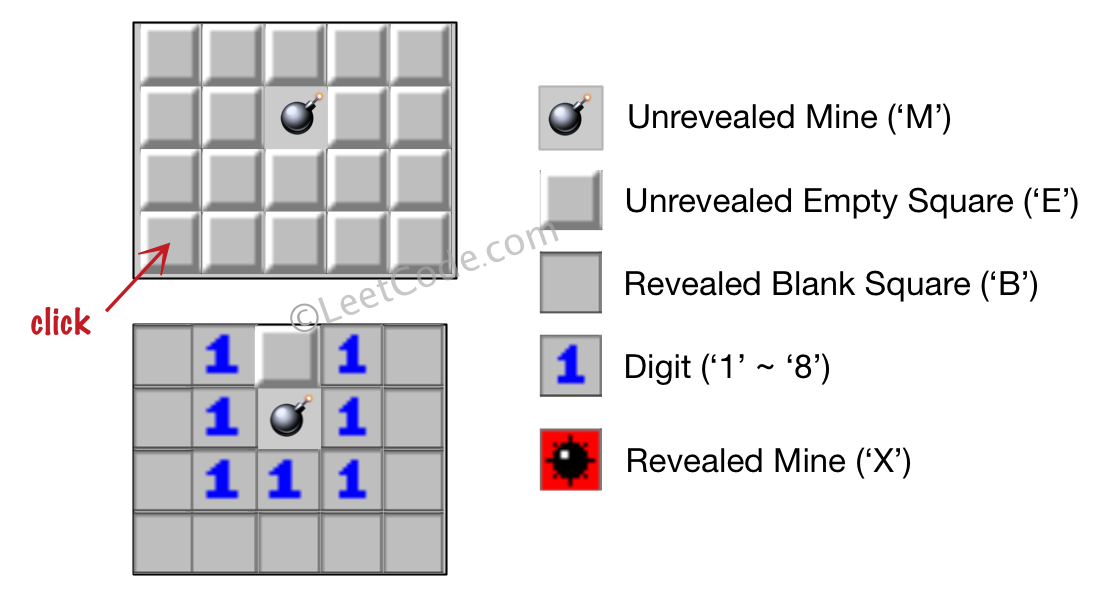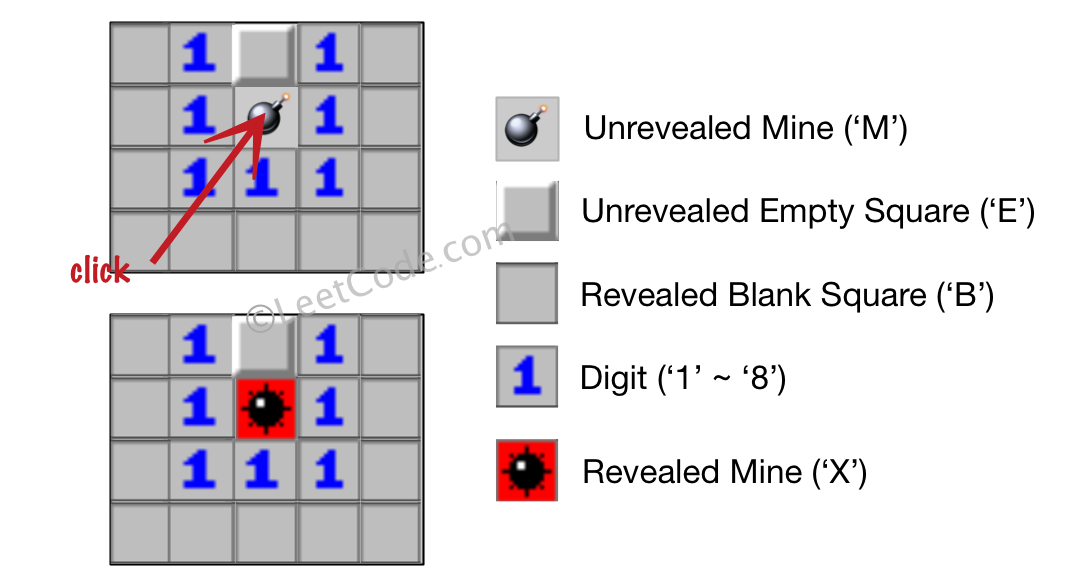529、Minesweeper
Let's play the minesweeper game (Wikipedia), online game)!
You are given a 2D char matrix representing the game board. 'M' represents an unrevealed mine, 'E' represents an unrevealed empty square, 'B' represents a revealed blank square that has no adjacent (above, below, left, right, and all 4 diagonals) mines, digit ('1' to '8') represents how many mines are adjacent to this revealed square, and finally 'X'represents a revealed mine.
Now given the next click position (row and column indices) among all the unrevealed squares ('M' or 'E'), return the board after revealing this position according to the following rules:
- If a mine ('M') is revealed, then the game is over - change it to 'X'.
- If an empty square ('E') with no adjacent mines is revealed, then change it to revealed blank ('B') and all of its adjacent unrevealed squares should be revealed recursively.
- If an empty square ('E') with at least one adjacent mine is revealed, then change it to a digit ('1' to '8') representing the number of adjacent mines.
- Return the board when no more squares will be revealed.
Example 1:
Input:
[['E', 'E', 'E', 'E', 'E'],
['E', 'E', 'M', 'E', 'E'],
['E', 'E', 'E', 'E', 'E'],
['E', 'E', 'E', 'E', 'E']]
Click : [3,0]
Output:
[['B', '1', 'E', '1', 'B'],
['B', '1', 'M', '1', 'B'],
['B', '1', '1', '1', 'B'],
['B', 'B', 'B', 'B', 'B']]
Explanation:

Example 2:
Input:
[['B', '1', 'E', '1', 'B'],
['B', '1', 'M', '1', 'B'],
['B', '1', '1', '1', 'B'],
['B', 'B', 'B', 'B', 'B']]
Click : [1,2]
Output:
[['B', '1', 'E', '1', 'B'],
['B', '1', 'X', '1', 'B'],
['B', '1', '1', '1', 'B'],
['B', 'B', 'B', 'B', 'B']]
Explanation:

Note:
- The range of the input matrix's height and width is [1,50].
- The click position will only be an unrevealed square ('M' or 'E'), which also means the input board contains at least one clickable square.
- The input board won't be a stage when game is over (some mines have been revealed).
- For simplicity, not mentioned rules should be ignored in this problem. For example, you don't need to reveal all the unrevealed mines when the game is over, consider any cases that you will win the game or flag any squares.
思路
经典扫雷。
对于当前需要点击的点,我们先判断是不是雷:
- 是:直接标记X返回即可
- 不是:数该点周围的雷个数,如果周围有雷,则当前点变为雷的个数并返回。如果没有的话,我们再对周围所有的点调用递归函数再点击即可
c++11
注意点:
第一次找周围雷个数的时候,若此时cnt个数为0并且标识是E,将位置记录下来。
如果最后雷个数确实为0,直接遍历我们保存下来为E的位置调用递归函数。
class Solution {
public:
vector<vector<char>> updateBoard(vector<vector<char>>& board, vector<int>& click) {
if (board.empty() || board[0].empty()) return {};
int m = board.size(), n = board[0].size(), row = click[0], col = click[1];
if (board[row][col] == 'M') {
board[row][col] == 'X';
return board;
}
vector<vector<int>> E_neighbors;
int M_cnt = 0;
for (int i = -1; i <=1; i++)
for (int j = -1; j <=1; j++) {
int new_row = row + i, new_col = col + j;
if (new_row < 0 || new_row >=m || new_col < 0 || new_col >= n) continue;
if (board[new_row][new_col] == 'M') M_cnt++;
else if (M_cnt == 0 && board[new_row][new_col] == 'E') // 如注意所示
E_neighbors.push_back({new_row, new_col});
}
if (M_cnt > 0) board[row][col] = M_cnt + '0';
else {å
for (auto neighbor : E_neighbors) {
board[neighbor[0]][neighbor[1]] = 'B';
updateBoard(board, neighbor);
}
}
return board;
}
};